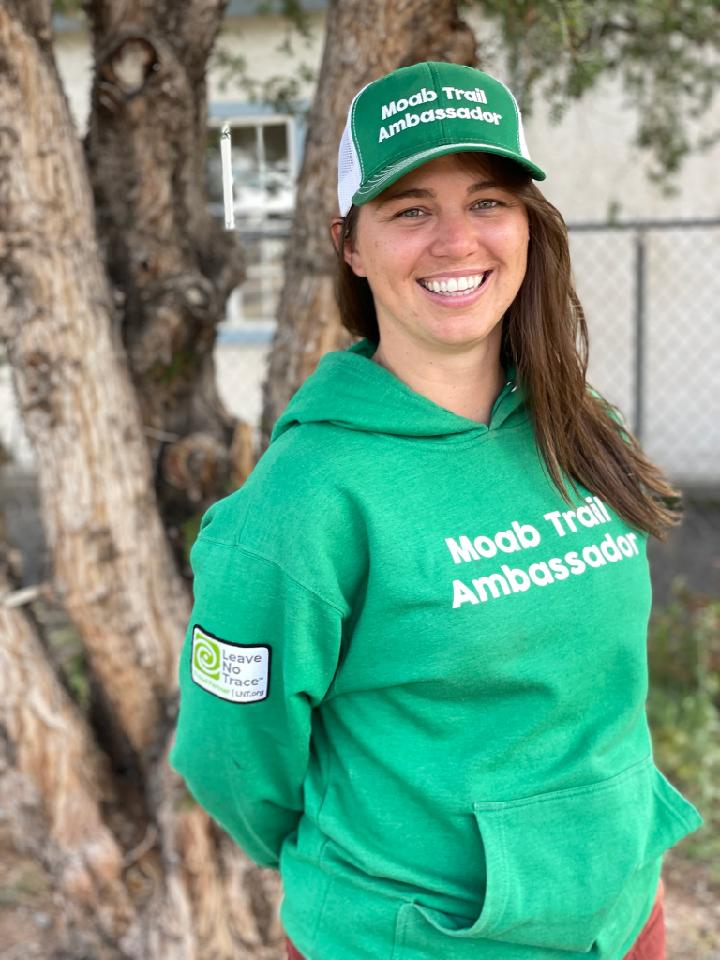Anna Sprout said she had always wanted to work for Grand County’s Active Transportation and Trails department. She had been teaching math at Grand County High School, and was working part time for GCATT as a trail ambassador, greeting and educating visitors at popular trailheads; she recently resigned from the school district and took on a new position as the Responsible Recreation Coordinator in the GCATT department. She’s now supervising the trail ambassadors and looking ahead to the program’s future.
Trail ambassadors
The trail ambassador program launched in the fall of 2021 (following a similar volunteer trail ambassador program), posting county staff at popular trailheads to greet visitors and share information about stewardship and safety. Sprout was one of the ambassadors at the program’s start.
“Having people on the ground, at the trailhead, is really important for preserving our beloved trails,” Sprout said. She has worked in a local bike shop and observed how difficult it is to convey stewardship messages during the hustle and bustle of renting equipment, when people are focused on getting their bikes and getting out of town.
“A lot of information is lost,” Sprout said—for example, about the fragile desert biocrust. “The biocrust is like a small forest that sits on top of or sand; most people don’t know.”
Ambassadors use an educational, rather than enforcement, approach with visitors. Sprout said staff are trained to use the “authority of the resource” to explain the reasoning behind rules. She said she’s met visitors on trails who have thanked ambassadors for being so respectful and helpful, and for pointing out actions that could damage the area (such as walking off trail).
The first season of the ambassador program was successful and the county created Sprout’s position to manage it into the future. It’s funded using transient room tax revenues. State code earmarks those funds for specific types of spending. Until recent changes in the code, a certain amount of transient room taxes was set aside for tourism promotion, and another portion was dedicated to mitigation of impacts from tourism. After recent TRT reforms, there are now four categories of spending: tourism promotion; mitigation of tourism impacts; economic diversification; and recreation, film, and conventions. Sprout’s position is funded by the recreation/film/convention portion of TRT revenues.
So far, the program is focused on three popular hiking trails: the Powerdam trailhead at Mill Creek Canyon; the Grandstaff Canyon trailhead; and the Corona Arch trailhead. These are some of the most-visited destinations around Moab: Sprout said that on a recent April Saturday, trail ambassadors counted over 1,000 visitors during a seven hour shift at the Corona Arch trailhead.
GCCAT is still looking for more trail ambassadors for the remainder of the spring, and for the fall, to expand its current staff of three.
Future goals
Sprout hopes that as the program gets more established, staff can start taking quantitative measurements to gauge visitor impacts and how much they may be mitigated by the presence and outreach of trail ambassadors.
Another future project is creating a junior Moab steward program through which kids can earn stickers or other prizes by demonstrating responsible recreation. Sprout noted that ambassadors take care to give out prizes as kids exit the trail, so they don’t inadvertently generate any litter on the trail.
She’s also been contacting online planning sites like AllTrails and Mountain Bike Project to collaborate on including tailored responsible recreation messaging on their Moab area pages. GCCAT and its nonprofit partner, Trail Mix, already maintain a social media presence, and Sprout hopes to further leverage that platform to foster a culture of stewardship.
Sprout said that while she knows some Moabites have a negative view on tourism, the trail ambassadors want visitors to feel valued and wanted, and to be affirmed in good stewardship of the landscape. “That’s the type of culture we want to have here,” she said.




